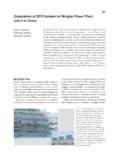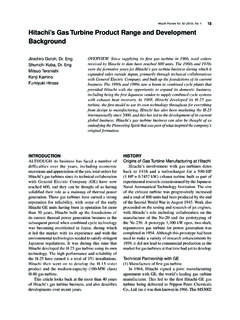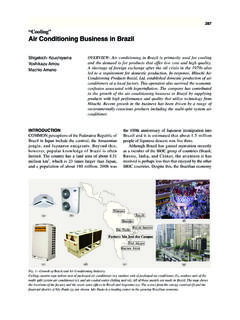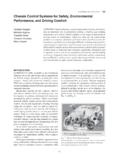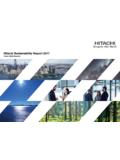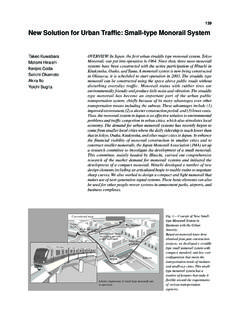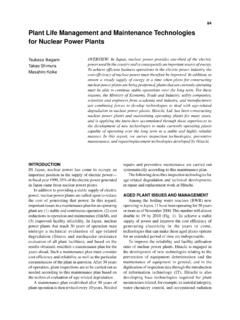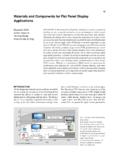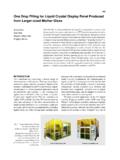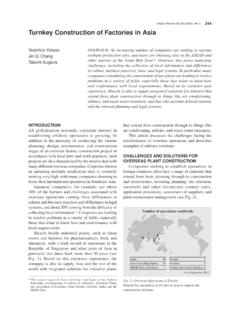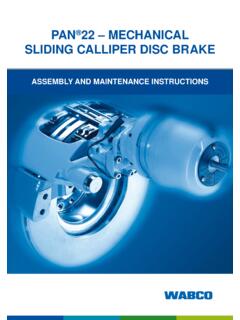Transcription of NVH Simulation Technology for Disc Brake Calipers
1 Hitachi Review Vol. 58 (2009), No. 7 341 NVH Simulation Technology for disc Brake CalipersToshitsugu SuzukiYoichi KumemuraHayuru InoueYuichi TakagiShinji SuzukiINTRODUCTIONIN recent years, although the dynamic performance of automobiles has improved radically, demand has been growing at the same time for both comfort and silence. This need for further improvements includes a reduction in the noise and vibration that can occasionally occur during braking, and which can give car occupants a feeling of organizations have been conducting vehicle evaluations to determine customer satisfaction levels recently, including the surveys of J.
2 D. Power and Associates in the USA and the automotive magazine auto, motor und sport in Germany. Poor evaluation results in these surveys are a major problem because they lead to reduced vehicle sales while causing damage to the automobile manufacturer s brand Brake noise and vibration are among the items evaluated in these surveys, further improvement is needed in these areas as well. The phenomena that cause these problems are complicated, and clarifying the mechanisms involved is a vital part of the improvement document describes the efforts of Hitachi with respect to technologies for analyzing NVH (noise, vibration, and harshness, whereby harshness refers to a lack of smoothness in the ride)
3 Caused by automobile disc Brake NOISE AND VIBRATIONN oises and vibrations in an automobile s disc brakes are a phenomenon caused by the discs coming into contact with friction material, resulting in frictional vibrations that generate resonance in the Brake components or vehicle body. Brake squeals and Brake judders are typical examples of these noises and vibrations, accounting for approximately 70% of : A comfortable automobile is one in which both noise and vibration are suppressed, and in which the conditions are satisfied for a smooth ride.
4 This is why NVH, which represents these conditions, has come to be used as an evaluation standard for automobile comfort. Noises that occur in disc brakes for automobiles come in a number of different categories, each with different causes. Of these categories, the noises referred to as Brake squeals and the vibrations referred to as Brake judders are caused by a complicated phenomenon whose reduction improves the value of automobiles on the market. Hitachi applies NVH analysis Technology to make improvements through both experimental trials and.
5 Automatic transmissionAbnormal noise typeNoise exampleCondition for occurrence (sound frequency)CountermeasureGroaning noiseGoo noiseSound generated in the instant that the foot is taken off the Brake pedal in a state such as when an AT car starts moving downhill, or when swing-over occurs while the car is halted (50 to 300 Hz) Appropriate selection and tuning of pad materialHumming noiseB noiseBoo noiseMoaning noiseSound that occurs when the car starts moving very slowly after the Brake is released, or during turning; this boon sound is particularly likely to occur in a rear disc (200 to 400 Hz) Reduction in drag Increased underbody rigidityRumbling noiseRoaring noiseGrinding noiseRoaring sounds such as goh, goh-goh that occur during the reduction of speed caused by o r d i n a r y b r a k i n g.
6 C a u s e d b y concave flexing in the surface of friction material, maturation of transferred film to the rotor surface and other factors (50 to 300 Hz) Pad material change Pad slit adjustmentClonking noiseClonking noiseSound occurring during ordinary b r a k i n g a t l o w s p e e d s ( i n particular during reverse driving after stopping, for instance), when the pad hits the torque member s torque support holeOptimization of the tangential direction gap between pad and torque memberRattle noisePin rattling noisePad rattling noiseRattling noise that occurs when metal parts hit each other during rough road driving (in the non-braking driving state), such as a pin and pinhole, or a pad and pad guide Pad clearance optimization Clearance optimization inside pinhole, 1.
7 Typical Types of Abnormal Noises Caused by disc BrakesAbnormal Brake noises occur under a wide range of conditions, and have different tones as well. Countermeasures must match the specific phenomenon in Simulation Technology for disc Brake Calipers 342 A Brake squeal is a noise between 1 and 16 kHz that is generated directly by the brakes. Since this is a phenomenon that is difficult to reproduce, and which varies depending on factors such as temperature, humidity, speed, and the force of the foot pressing down on the pedal, countermeasures are difficult to vibrations, vehicle body vibrations, and Brake pedal vibrations can also be caused by gradual braking (deceleration between and 3 m/s2) during high-speed driving.
8 These vibration phenomena that occur during braking are referred to with the generic term Brake judder. Brake judders, which are one form of low-frequency vibration, occur when Brake vibration during braking travels from underbody parts into the steering, resulting in sympathetic vibration. Sometimes this can cause the vehicle body to resonate to the extent that the vehicle body itself vibrates, making a groaning noise throughout the entire vehicle body. The main sources of this phenomenon are steady vibration of the vehicle body system by the braking system and the resonance characteristics of the frictional vibration with the vehicle body.
9 The inputted exciting forces include fluctuation in the braking torque, which is caused by disc deformation and uneven of noises and vibrations related to automobile brakes other than Brake squeals and Brake judders are shown in Table is working on measures to prevent the wide variety of NVH problems related to NOISES AND NOISE ANALYSIS TECHNOLOGYThis section discusses the causes of Brake squeals and the Technology used to analyze general, friction brakes use sliding caused by dry friction to generate a braking force, which always results in tiny fluctuations in the frictional force.
10 This can then resonate with the parts around the lining material, further amplifying the fluctuations in frictional force and causing parts with a relatively large surface area to vibrate, which in turn vibrates the air and generates a noise. This is referred to as self-exciting vibration, and Brake squeals are a typical example of the factors behind Brake squeals include the physical characteristics of friction material such as friction coefficient speed dependencies, thermal factors caused by disc thermal deformation and so on, and structural factors caused by issues such as the form of Brake vibrations.
